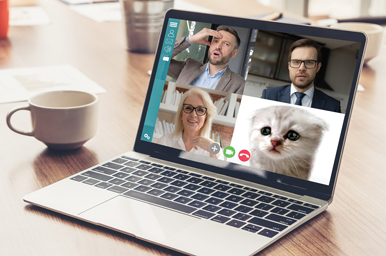
We’ve all seen the Zoom fails on social media—the banana filter gone bad, the boxer-clad spouse sauntering into frame. But IRL, online offenses are not a LOL matter.
The average American worker is getting more screen time than ever before, sorting through 32 text messages and 121 emails each day and spending nearly 22 hours per week in virtual meetings. Kogod professor Hayley Blunden wants to help people ensure that all those digital impressions are positive and professional.
“I have long been interested in how interacting virtually influences how we relate to one another, especially within a workplace context,” says Blunden, who joined the Department of Management in 2022 after working in strategy, consulting, and finance for companies ranging from a small start-up to a Fortune 100 firm. “In the private sector, I observed the power of workplace relationships in driving results. These relationships are essentially the sum of a series of interactions.”
Blunden’s new paper, “A Review of Virtual Impression Management Behaviors and Outcomes,” coauthored by Andrew Brodsky of the University of Texas at Austin, synthesizes existing research on digital interactions from a variety of disciplines, including business, technology, communications, and even medicine. Published in the Journal of Management, the article also offers tips for employees, 58 percent of whom work remotely at least part of the time, according to McKinsey’s American Opportunity Survey.
Misspelling a word in an email, forgetting to mute in a meeting, and opting for an overly complicated Zoom background or silly filter are among the small missteps than can make a difference in how people are viewed by their peers and supervisors.
“One big takeaway from this work is that virtual interaction is really quite rich in driving others’ impressions of us,” Blunden says. “Although we may quickly fire off an email or shoot someone a text without thinking about it too much, the seemingly minor choices we make during these interactions can influence how we are viewed.”
Empirical studies indicate that typos in emails or texts can negatively impact others’ impressions of the sender, Blunden says. “Just taking that extra step to double-check our writing or use a grammar-checking service can influence how we’re viewed.”
Still, Blunden and Brodsky’s work also revealed some instances in which people overvalue the effort necessary to manage others’ impressions. One study found that people often overestimate how quickly their boss expects a reply to their email, for example.
Blunden, who teaches classes in organizational behavior and human capital, also stresses that virtual impressions are lasting.
“Not only can I reread and forward emails, texts, and chats, but I can also record and disseminate a video conference. These features suggest that the impressions we make virtually could be more consequential than the more fleeting impressions we make in person,” she says. “Virtual communication permanence is often what generates the headline we see when virtual interaction goes wrong. People’s unthinking emails are forwarded to a client or uncaring video calls are posted to the internet.”